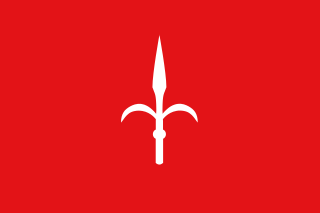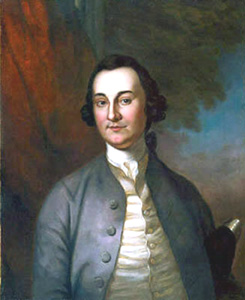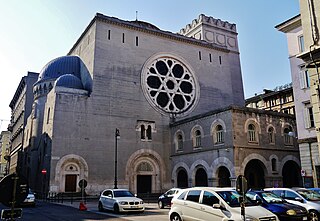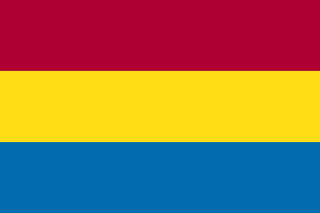Related Research Articles

Trieste is a city and seaport in northeastern Italy. It is the capital and largest city of the autonomous region of Friuli Venezia Giulia, as well as of the regional decentralization entity of Trieste.

The Free Territory of Trieste was an independent territory in Southern Europe between northern Italy and Yugoslavia, facing the north part of the Adriatic Sea, under direct responsibility of the United Nations Security Council in the aftermath of World War II. For a period of seven years, it acted as a free city.

Isaac Low was an American merchant in New York City who served as a member of the Continental Congress, where he signed the Continental Association. He later served as a delegate to the New York Provincial Congress. Though originally a Patriot, he later joined the Loyalist cause in the American Revolution.

George Plater III was an American planter, lawyer, and statesman from Saint Mary's County, Maryland. He represented Maryland in the Continental Congress from 1778 to 1780, and briefly served as the sixth Governor of Maryland in 1791 and 1792.

The history of the Jews in Trieste goes back over 800 years.

Antonio María de Bucareli y Ursúa was a Spanish military officer, governor of Cuba, and Viceroy of New Spain (1771–1779) during the time of Spanish colonization of California. He was Knight of Justice of the Order of Malta.

George Bryan was an Irish/American Pennsylvania businessman, and politician of the Revolutionary era. He served as the first vice-president of Pennsylvania and its second president (governor) following the Declaration of Independence from Great Britain. He was an early abolitionist and sponsored the bill which helped bring about abolition in Philadelphia. He also served as a judge of the Pennsylvania Supreme Court.

The history of the Jews in Livorno, Italy has been documented since 1583, when descendants of the late 15th-century expulsions from Spain and Portugal settled in the city. They were settled initially by Sephardic Jews from Pisa. The Jewish community of Livorno, although the youngest among the historic Jewish communities of Italy, was for some time the foremost: its members achieved political rights and wealth, and contributed to scholarship in the thriving port city. Numerous Jewish schools and welfare institutions were established.
Rijeka, formerly known as Fiume, is a city located in the northern tip of the Kvarner Gulf in the northern Adriatic. It is currently the third-largest city in Croatia. It was part of the Roman province of Dalmatia, and later of the Kingdom of Croatia. It grew during the 12th to 14th centuries as a seaport within the Holy Roman Empire, trading with Italian cities. Under the rule of the House of Habsburg from 1466, it was made a free city; and, although part of the Duchy of Carniola, it developed local self-government.

Corpus separatum, a Latin term meaning "separated body", refers to the status of the City of Fiume while given a special legal and political status different from its environment under the rule of the Kingdom of Hungary. Formally known as City of Fiume and its District, it was instituted by Empress Maria Theresa in 1779, determining the semi-autonomous status of Fiume within the Habsburg monarchy until the fall of the Austro-Hungarian Empire in 1918.
Pasquale Ricci may refer to:

Count Karl von Zinzendorf und Pottendorf was a Saxon-Austrian civil servant. He served the government of Austria in a variety of capacities, including as governor of Trieste, and rose to high rank at the Habsburg court. His massive diary, written daily over a period of about 66 years, is an important historical documentary source for his era, both in politics and in the arts.

Serbs in Italy, also referred to as Serbian Italians or Italian Serbs are a community numbering 46,958.

The Imperial Free City of Trieste and its Territory was a possession of the Habsburg monarchy in the Holy Roman Empire from the 14th century to 1806, a constituent part of the German Confederation and the Austrian Littoral from 1849 to 1920, and part of the Italian Julian March until 1922. In 1719 it was declared a free port by Emperor Charles VI; the construction of the Austrian Southern Railway (1841–57) turned it into a bustling seaport, through which much of the exports and imports of the Austrian Lands were channelled. The city administration and economy were dominated by the city's Italian population element; Italian was the language of administration and jurisdiction. In the later 19th and early 20th century, the city attracted the immigration of workers from the city's hinterlands, many of whom were speakers of Slovene.
The Port Jew concept was formulated by Lois Dubin and David Sorkin in the late 1990s as a social type that describes Jews who were involved in the seafaring and maritime economy of Europe, especially in the seventeenth and eighteenth centuries. Helen Fry suggests that they could be considered to have been "the earliest modern Jews."
Austrian East India Company is a catchall term referring to a series of Austrian trading companies based in Ostend and Trieste. The Imperial Asiatic Company of Trieste and Antwerp and Asiatic Company of Trieste or the Trieste Company were founded by William Bolts in 1775 and wound up in 1785.
The Imperial Privileged Oriental Company was a state-organized Austrian trading company at the time of Charles VI. 1719 to 1740.

The Trieste Commodity Exchange was founded in 1755 by Empress Maria Theresa. It is one of the oldest commodity exchanges in the world.
The history of the Jews in Ancona in Italy, began when Jews settled into the city in the first half of the 14th century, contributing to money-lending and other economic roles.
The history of Trieste began with the formation of a town of modest size in pre-Roman times, which became an actual city only after Roman conquest in the second century BC and subsequent colonisation. After the imperial era, the city declined following barbarian invasions, becoming only marginally important for the next millennium. It changed lordships several times and then became a free city, which joined the House of Habsburg in 1382. Between the 18th and 19th centuries Trieste experienced a new period of prosperity thanks to the free port and the development of a thriving shipping industry that made it one of the most important cities of the Austrian Empire.
References
- 1 2 3 4 Daniele Andreozzi (2005). "Tra centro e periferia: Pasquale Ricci e la Commissione sulle manifatture e fabbriche del Litorale (1763–1776)". In Daniele Andreozzi and Carlo Gatti (ed.). Trieste e l'Adriatico: Uomini, merci, conflitti (PDF). University of Trieste. ISBN 88-8303-163-6.
- 1 2 Lois C. Dubin (1999). The Port Jews of Habsburg Trieste: Absolutist Politics and Enlightenment Culture. Stanford University Press. pp. 13–14. ISBN 0-8047-3320-1.